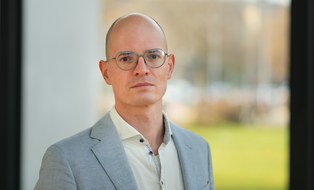BOND2BEND
| Project Title | BOND2BEND |
| Project Subtitle | Bonded insulating glazing for cold bending in facades |
| Project Leader |
Prof. Dr.-Ing. Michael Engelmann (TU Dresden) |
| Researcher | Dipl.-Ing. Johannes Giese-Hinz (TU Dresden) |
| Partners | POLARTHERM FLACHGLAS GMBH |
| Funding | BMWK – Zentrales Innovationsprogramm Mittelstand (ZIM) |
| Time Span | 2023-2024 |
Project Description
Innovative architectural drafts of the building shell, as they are processed by planning offices in structural planning, often provide for curved constructions. Due to the desired transparency, this often entails the need for curved glass panes. Desirable for industrial production and use in facades are therefore curved glass elements with a high optical quality, which can be individually adapted to any form, do not require any laborious bending processes and can be attached invisibly from the outside. This can be achieved with cold-bent insulating glass panes in connection with an invisible load-bearing adhesive to the substructure.
This is the goal of the research project BOND2BEND. The planned solution envisages the use of an initially flat insulating glass, which is bonded to an adapter frame in a load-bearing manner. At the construction site, this element can be screwed onto the curved substructure and forced into the bend. The elements are thereby able to take on the function of insulating glass in curved facades with optically excellent quality and invisible fastening. The elements are to be developed as a system construction with a high degree of prefabrication, so that on-site assembly can be carried out quickly.
In order to use cold-bent glass panes extensively in facade construction, considerable knowledge is required about the permanent stresses as well as the design of the edge bond and the structural bonding between the glass and the substructure. The development of an assessment concept is necessary to enable the application and to verify the sufficient load-bearing capacity, taking into account time-dependent material properties as well as the partial safety concept according to Eurocode 0 (DIN EN 1990).
The first focus of the project is the development of a structural edge bond for the insulating glass, which has to be able to transfer known stresses of an insulating glass as well as permanent stress resulting from the bending of the outer glass pane to the edge of the inner glass pane. Extremely important is thereby the permanent impermeability of the insulating glass for its insulating function.
The second focus of the project is the development of the permanently stressed structural bond between the insulating glass and the adapter profile. In comparison to other structural adhesives in facades, this adhesive have to transfer constant stress due to the restoring forces from the cold-bent insulating glazing to the substructure in addition to the tensile stress caused by wind loads.
Contact Person TU Dresden
 © Franziska Rehde
© Franziska Rehde
Research Associate
NameDipl.-Ing. Johannes Giese-Hinz
Send encrypted email via the SecureMail portal (for TUD external users only).
Institute of Building Construction
Institute of Building Construction
Visiting address:
NÜR, Room 06-021 Nürnberger Straße 31A
01187 Dresden
 © Franziska Rehde
© Franziska Rehde
Professor of Sustainable Building Construction
NameProf. Dr.-Ing. Michael Engelmann
Head of the Institute of Building Construction
Send encrypted email via the SecureMail portal (for TUD external users only).
Institute of Building Construction
Institute of Building Construction
Visiting address:
NÜR, 06-018 Nürnberger Straße 31A
01187 Dresden
